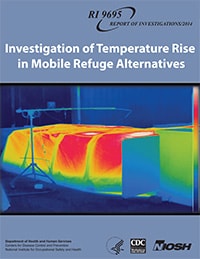Mining Publication: Investigation of Temperature Rise in Mobile Refuge Alternatives
Original creation date: March 2014
Authors: DS Yantek
NIOSHTIC2 Number: 20043881
Pittsburgh, PA: U.S. Department of Health and Human Services, Public Health Service, Centers for Disease Control and Prevention, National Institute for Occupational Safety and Health, DHHS (NIOSH) Publication No. 2014-117, (RI 9695), 2014 Mar; :1-63
One of the initial and persistent concerns over the use of mobile refuge alternatives (RA) is the temperature rise inside the RA from the metabolic heat of the occupants and the heat released by the CO2 scrubbing system. Moreover, the humidity within the RA will increase as the occupants lose water through respiration and perspiration. The National Institute for Occupational Safety and Health (NIOSH) Office of Mine Safety and Health Research (OMSHR) in its 2007 report to Congress on refuge alternatives recommended that refuge alternatives be designed and deployed to ensure that a temperature-humidity metric known as apparent temperature not exceed 95°F. Subsequently the Mine Safety and Health Administration (MSHA) adopted this recommendation [30 CFR 7.504 (b)(1)].
Notwithstanding the above process, a standard method to determine compliance with this metric does not exist. The heat transfer process in an RA, including the contributions of the human occupants, is highly complex, and is not easily defined analytically or experimentally. NIOSH initiated research in 2008 with the goal of developing a technical foundation for such analytical and experimental procedures. Based on a significant amount of preliminary work at the Lake Lynn Experimental Mine, at NIOSH’s Pittsburgh Research Laboratory, and at manufacturer facilities, the project was focused to address four research questions.
- Does the mine behave as an infinite heat sink? The engineering assumption that a mine does behave as an infinite heat sink was applied in the calculations originally used to certify mobile RAs, and is being applied in the design of tests to the present. If a mine can be assumed to behave as an infinite heat sink, then the temperature rise within an RA would be significantly less for a given configuration than if the mine does not behave as an infinite heat sink.
- Does the facility in which the test is conducted impact the resulting temperature rise?
- Will the moisture generated by the occupants reduce the air temperature within the RA?
- Could occupancy derating values be used for RAs that are rated and approved for use at one mine ambient temperature, but are deployed in a mine with a higher ambient temperature?
Experimental and analytical studies, described in this report, were designed to answer these questions. Each of the studies contributed incrementally to the overall understanding of the problem, and the knowledge gained in one step was applied in the next to further the understanding of temperature rise in RAs. A recently completed “capstone” study provided data to answer the research questions and to validate the numerical model developed in the project. The four research questions were addressed and answers are presented in this report.

NIOSHTIC2 Number: 20043881
Pittsburgh, PA: U.S. Department of Health and Human Services, Public Health Service, Centers for Disease Control and Prevention, National Institute for Occupational Safety and Health, DHHS (NIOSH) Publication No. 2014-117, (RI 9695), 2014 Mar; :1-63
- Analysis of Heat Loss Mechanisms for Mobile Tent-Type Refuge Alternatives
- Announcing Two New Sister Publications on Refuge Alternatives
- Development of Heat Mitigation Systems for Refuge Alternatives used in Underground Coal Mines
- Effects of Mine Strata Thermal Behavior and Mine Initial Temperatures on Mobile Refuge Alternative Temperature
- Estimation of Metabolic Heat Input for Refuge Alternative Thermal Testing and Simulation
- Investigation of Purging and Airlock Contamination of Mobile Refuge Alternatives
- NIOSH Refuge Alternative Webinar
- Portable Refuge Alternatives Temperature and Humidity Tests
- Prediction of Human Core Temperature Rise and Moisture Loss in Refuge Alternatives for Underground Coal Mines
- RA Heat Mitigation System Utilizing Advanced Liquid Air Technologies
- Refuge Chambers
- Temperature Rise Within a Mobile Refuge Alternative (RA) - Experimental Investigation and Model Validation
- Validation of Temperature and Humidity Thermal Model of 23-person Tent-type Refuge Alternative